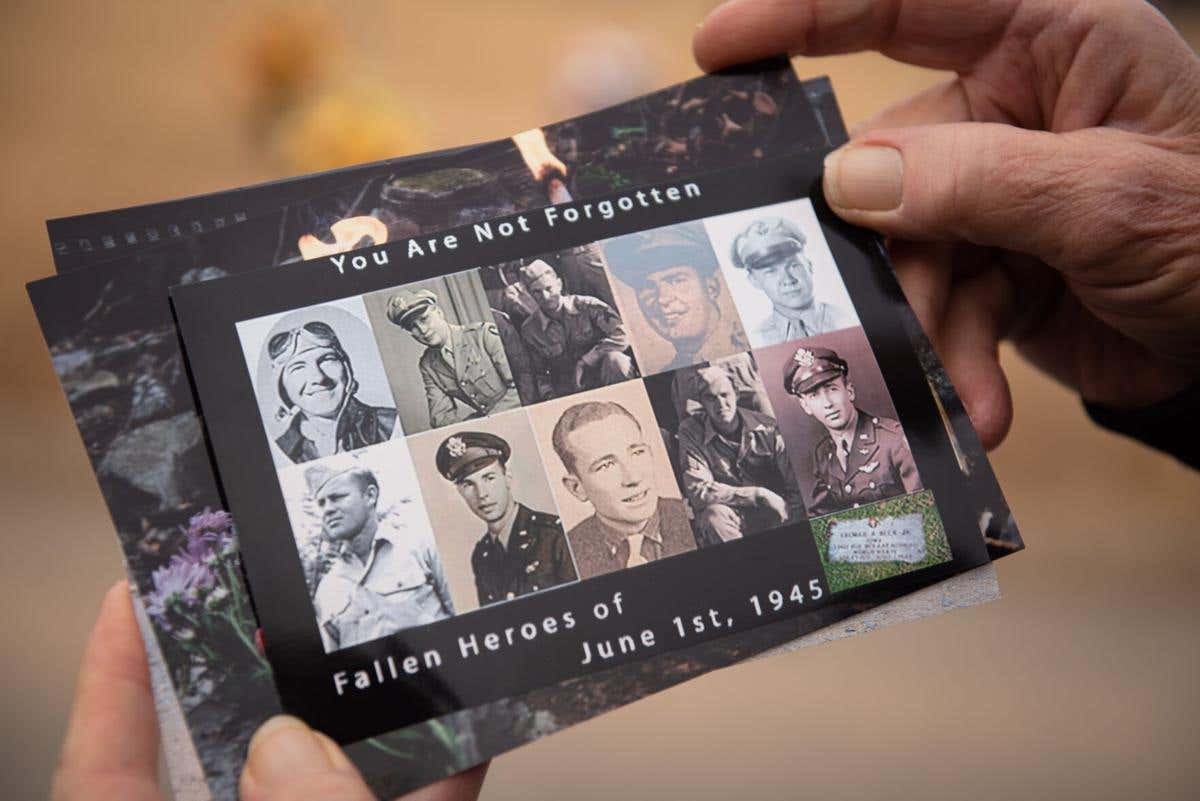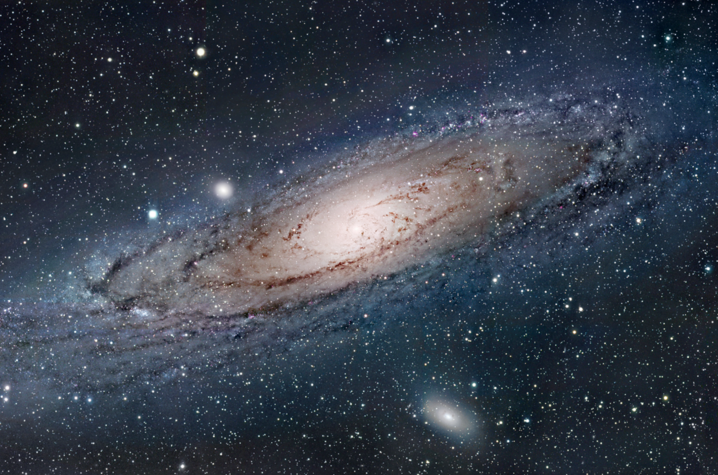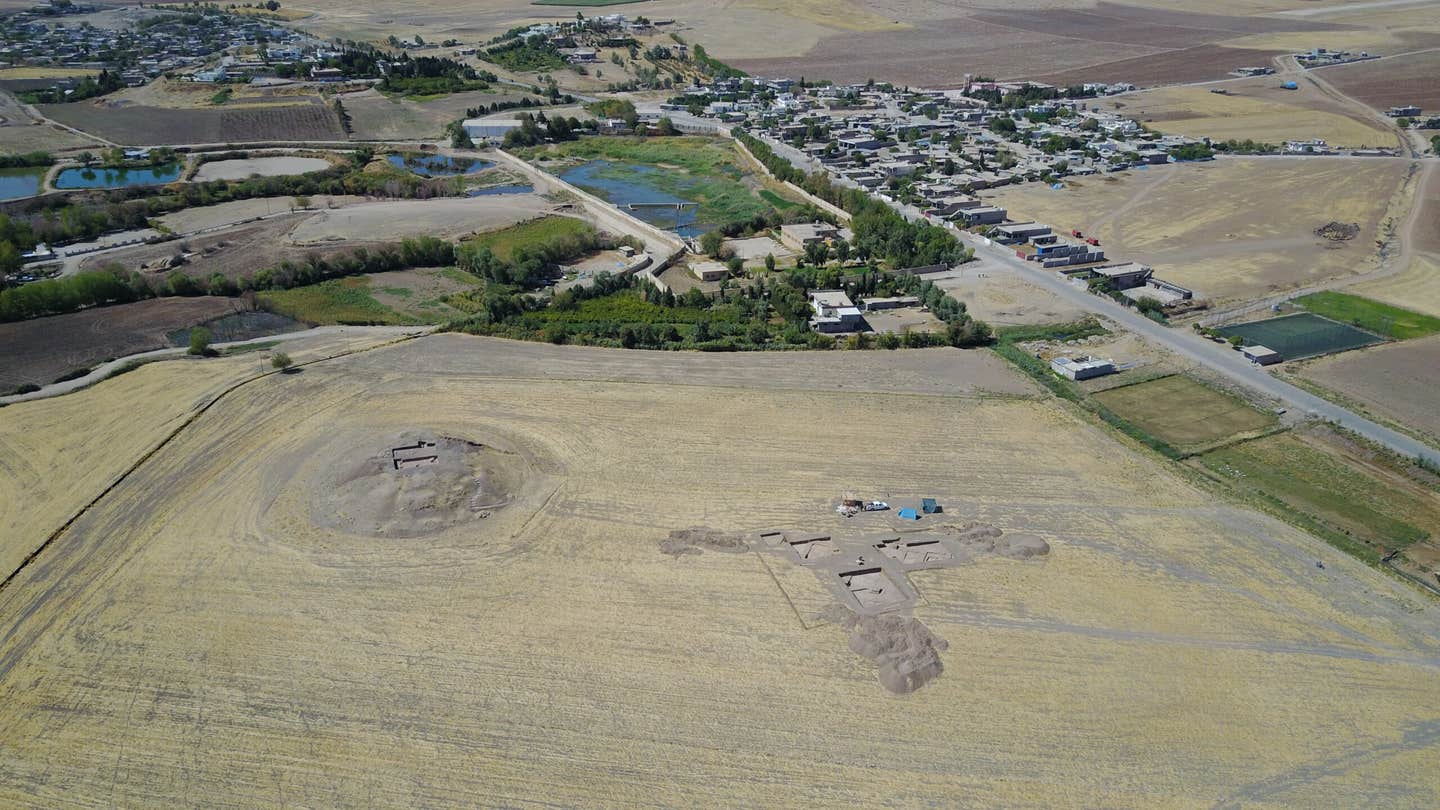Act of kindness connects man to brother lost in the last days of World War II
Jerry Isley received earlier this year a rather unusual gift from an unlikely source, an acquaintance he’d met in person once or twice.

[Dec 28, 2021: Scott Sexton]
Jerry Isley holds a card of all of the fallen soldiers, including his brother, Cpl. William Isley, who died when a B-29 airplane crashed during a mission to Osaka, Japan, on June 1, 1945. (CREDIT: Allison Lee Isley)
Jerry Isley received earlier this year a rather unusual gift from an unlikely source, an acquaintance he’d met in person once or twice.
Not too long after Memorial Day, the man — a freelance journalist named David Caprara — arrived at Isley’s home in Walkertown bearing a rock he’d taken from the side of a mountain near Osaka, Japan.
“It was very moving,” Isley said. “Brought a tear to my eye.”
It wasn’t so much the rock, where it came from or the man who carried it from the other side of the world that caused such a strong reaction.
Rather, it was what the rock represented: the memory of Jerry’s older brother William “Buddy” Isley, who was among the last of some 407,000 Americans killed in World War II.
Buddy and all of his crewmates on a B-29 Superfortress bomber died following a crash into the side of that mountain on June 1, 1945, just 2½ months before the emperor announced Japan’s surrender.
“Caprara drove several hours out of his way,” Isley said. “He didn’t have to do that. But it meant a lot that he did.”
A mystery spanning decades
The Isleys, all eight of them, grew up poor in Walkertown even if they didn’t realize it fully.
“That was back when it wasn’t like today. Kids were more of a liability,” he said. “There were eight of us; seven lived until 2017 when my sister died.”
Another sister followed in 2019 and a third this year.
Related Stories
“Three boys and one girl left,” Isley said, wholeheartedly agreeing with the notion that the Isleys have a longevity gene in the family line. “We do. Mom lived to be 96.”
Jerry Isley holds a card of his brother, Cpl. William Isley, who died when a B-29 airplane crashed during a mission to Osaka, Japan, on June 1, 1945. (CREDIT: Allison Lee Isley)
The exception, of course, was Buddy, who joined the U.S. Army Air Corps when he was old enough. “He didn’t want the Army (infantry) so he volunteered,” Isley said. “He wanted to be a pilot, but his eyes didn’t let him.”
Instead, he was trained as a waist gunner and assigned to a crew flying a B-29 bomber in the Pacific Theater
Early on the morning of June 1, 1945, a firebombing mission to the Japanese mainland including Isley’s plane lifted off from the Mariana Islands more than 1,200 miles away.
The superfortress carrying Isley and 10 other crew members, Capara wrote in a 2020 story published in the Japan Times, lost an engine as it approached Osaka. Most likely, the plane had been hit by anti-aircraft gunfire.
In an attempt to lighten the load, the crew dumped the B-29’s bombs. But it wasn’t enough to allow the plane to clear a tall ridgeline in a remote area mostly unaffected by the war.
Seven crew members, including Buddy Isley, died instantly. The other four managed to bail out. They were captured and held by local authorities until being executed in July, mere weeks before the surrender on Aug. 15, 1945.
Some of those local authorities were later convicted of war crimes for carrying out extrajudicial killings so close to the end of the war.
Still, for years afterward the crash — even its exact location — remained a mystery to local residents, Caprara wrote.
“The plane crashed alone deep in these mountains so far away from America,” Kiyotaka Kobayashi told Caprara.
Kobayashi was among a search party looking for a lost hiker who found the wreckage in the early 1990; he told Caprara, who had settled in the area, about it years later when the journalist was researching the crash.
“Seeing these parts of the plane made me feel sad, prompting me to reflect upon the war,” Kobayashi said.
For the families of the slain airmen, the mystery — and the sadness it caused — was even greater.
‘Mom knew’
Back in Walkertown, Isley — 10 years old at the time — remembers the family receiving mail from the Army that autumn.
“Mom got a package with just his billfold in it,” Isley said. “She knew something was wrong. Dad and my sisters wrote the Army and anybody they could think of. The Army kept telling them they just didn’t know.”
Actually, the Army did know. It just hadn’t secured enough proof or located the fliers’ remains so the men were officially declared missing.
Families learned years later that the military had found the crash site in December, arranged for a common grave and had a memorial service.
The next year, 1946, families were told that the airmen had in fact been killed. Three years after that, Isley said, “we got Buddy back.”
“That helped my mom with closure,” Isley said. “We buried him in the Gardens of Memory and put flowers on his grave every holiday.”
Isley learned more after being contacted by Caprara, who had decided to make a documentary film about the crash.
Buddy was the only airman who still had living siblings, Isley said, and Caprara reached out to learn about his life before the war.
Caprara arranged to film an interview, which was included in his 50-minute documentary “Fallen Fortress.”
(It’s available to livestream at www3.nhl.or.jp the website for NHK World-Japan, an English language news channel carried on many cable systems.)
Buddy Isley liked cars and hung around service stations trying to learn everything he could about engines before he enlisted. He loved Arizona, too, where he’d lived at one time. “He said he wanted to go live there once he came back from the service,” Isley said.
He never made it.
Out of the blue, Caprara called Isley this summer. He’d hiked to the crash site on Memorial Day and held his own service to honor the dead.
“He read something about every victim,” Isley said. “That was very nice to hear. Very moving.”
Caprara also mentioned that he’d brought a gift, a small stone from the site, that he hoped could serve as a physical connection to Buddy for his surviving siblings.
Stories about the anniversary of the attack on Pearl Harbor, along with learning that Caprara’s film would premier earlier this month, caused Isley to think once again about Caprara’s act of kindness.
“Buddy was real, real special,” Isley said. “I always wondered what he’d have done if he made it back.”
For more good news stories check out our Good News section at The Brighter Side of News.
Note: Materials provided above by Scott Sexton. Content may be edited for style and length.
Like these kind of feel good stories? Get the Brighter Side of News' newsletter.
Tags: #Good_News, #Kindness, #Military, #Heroes, #Brothers, #Siblings, #War, #Rememberance, #The_Brighter_Side_of_News



